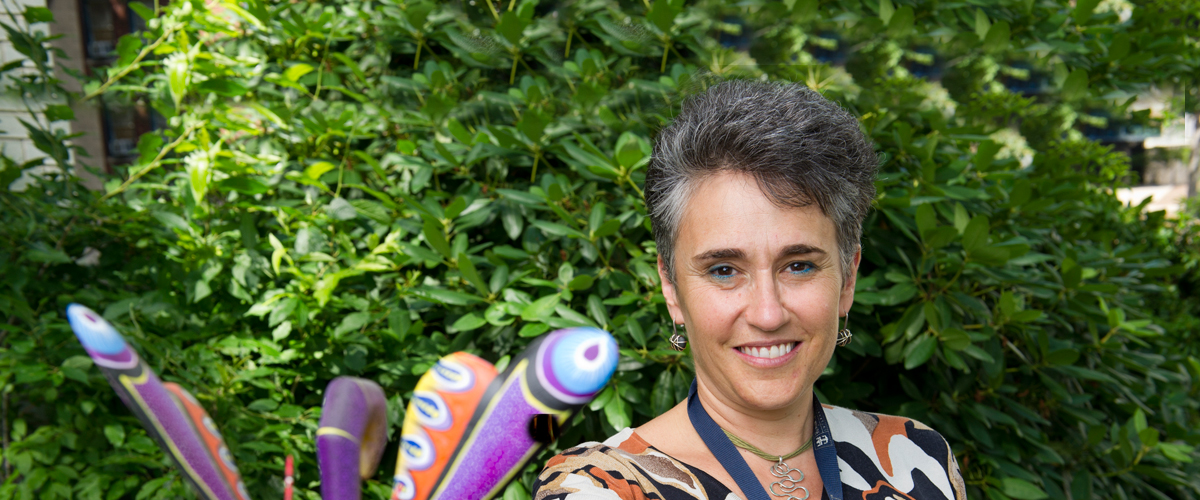by Angela Herring
There are more than 3,000 species of termites in the world, all living in social colonies with distinct hierarchies. They can be devastating pests, with the ability to destroy entire buildings. But they’re also an important component of natural ecosystems, with much to teach us about soil nutrient recycling. Still, neither of these facts is what gets Rebeca Rosengaus, an associate professor of biology in the department of marine and environmental sciences, out of bed in the morning. As she put it, “I’m interested in them because they’re neat.”
In the vast majority of termite colonies, a single king-queen pair is responsible for reproduction. But in the early 1980s, researchers discovered something very odd when they looked inside the mature arboreal nests of one species, Nasutitermes corniger: About 20 percent of the colonies were headed by what looked like “mini-orgies,” said Rosengaus, who has been studying social insects like termites and ants for 30 years.
Many ant colonies show similar polygamous tendencies, said Rosengaus, but not termites. “In ants, those colonies that are started by multiple reproductive females have certain benefits,” she explained. “So they grow faster or produce workers at a faster rate.” This behavior of establishing colonies in groups is called pleometrosis and for 30 years, researchers have assumed it was how the handful of polygamous termite colonies formed.
Rosengaus and her student Tamara Hartke, now a Sir Keith Murdoch Fellow at the Center for Integrative Bee Research in Australia, tip that long-held assumption on its head in work recently published in the journal Proceedings of the Royal Society B.
With funding from a National Science Foundation Career Award, Hartke and Rosengaus collaborated with the Smithsonian Tropical Research Institute in Panama to study the polygamous N. cornigercolonies. The team sorted more than 16,000 reproductive termites into petri dishes. Some had just one reproductive pair, but others had as many as five kings and queens.
They supplemented these artificial experiments with observations of both seminatural and naturally established colonies, which the team dug out of the Panamanian forest floor. The results of each of the experiments were the same: Termite colonies started by more than one reproductive pair were much less successful than their single-pair counterparts, ruling out pleometrosis as the route by which mature polygamous colonies get their start.
Young termite colonies start out in microbial-rich environments like soil or a dead or rotting wood, according to Rosengaus. If the eggs aren’t kept clean and moved often, they become infected with fungus. “Termite parents are really very conscientious about cleaning their baby eggs and keeping them in a pile all together,” she explained. “They spend a lot of time doing this type of parental care.”
Hartke and Rosengaus speculate that reproductives in pleometrotic colonies spend less time on egg care than monogamous pairs. Instead, the members of a founding group seem to be engaging in subtle reproductive competition, diverting energy toward interacting with each other rather than toward their own offspring. This, said Rosengaus, may explain why pleometrotic groups have lower hatching rates.
“There should, theoretically and based on observations of other social organisms, be survival or colony-growth benefits to establishing a colony with more reproductives, so in that sense it was surprising to find more costs than benefits,” said Hartke.
The authors suspect that neighboring termite colonies eventually merge into one as they grow and mature. The king-queen pairs of each individual colony persist—and now that workers take care of the parental duties, the competition seen in nascent pleometrotic colonies disappears.
Rosengaus hopes to continue pursuing her work with what she calls these “weird” colonies, adding important genetic data to the mix. “Any question about evolution of sociality needs to be analyzed by using a variety of methods, including molecular and genetic techniques to better understand the system,” she said.
Originally published in news@Northeastern on February 11, 2013

